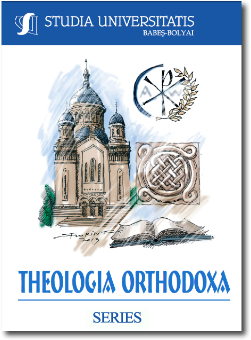THE SPLENDOUR OF THE DEIFIED FLESH. GLORIFICATION (δεδοξασμένη) AND DEIFICATION (θέωσις) INTO A CONTINUUM OF THEOPHANIES
THE SPLENDOUR OF THE DEIFIED FLESH. GLORIFICATION (δεδοξασμένη) AND DEIFICATION (θέωσις) INTO A CONTINUUM OF THEOPHANIES
Author(s): Nichifor TănaseSubject(s): Theology and Religion
Published by: Studia Universitatis Babes-Bolyai
Keywords: Glorification; Deification (Theosis); uncreated energies; Kabod (Doxa); Thaboric light; Shem; Name of Christ; Hesychastic prayer; Shekinah; Uncreated light; somatic experience of glory; Eucharist...
Summary/Abstract: Saint Paul refers to Christ’s ability to radiate his divine light of himself while other OT luminaries like Moses could only reflect that light. This experience of theosis is being, also, described as “transformation into unveiled glory” (2 Cor. 3.7-18). By this verse deification through the vision of God becomes an immanent and mystical event. This aspect of deification as transformation into glory (glorification) is both an inward quality of spiritual knowledge and an outward radiance. The nature of the glory of Moses and the visible splendour shining from his face from his direct contact with God (Exod 34.29) signifies God’s visible, divine presence. As all believers encounter God directly (with unveiled faces) through the Spirit’s presence they reflect this glory as mirrors and are themselves glorified in the process (from glory to glory). The transformation into this glory is not only noetic but also embodied because it is a visible manifestation. The noetic enlightenment is associated with participation in divine glory in 2 Cor 3-4 and is correlated to the somatic experience of glory in 2 Cor 4:16-5:5. Paul speaks also of this epistemic process of contemplation which generates the ontological mirroring process. And, because for us there is no veil over the face, we all see as in a mirror the glory of the Lord, and we are being transformed (μεταμορφούμεθα) into his image (τὴν αὐτὴν εἰκόνα) with ever-increasing glory. But Luke is the only evangelist to use the word “glory” (doxa) and the only to mention that Jesus and the three apostles went up the mountain specifically to pray (Lk 9:29-31). This is a detail in spiritual tradition of hesychasm which was richly developed, the vision of light at the culmination of intense periods of prayer is the deification of our nature. This light is an enhypostatic symbol, the uncreated radiance of God, a divine energy. This manifestation of Christ in the divine nature is not something external to ourselves. It is interiorized through the life of ascetism and prayer. Christ will radiate within us. But this pneumatic nature of Christ’s luminous body is experienced through Eucharist as well. This holy sacrament accesses the divine light, veiled by Christ’s visible body. Also, Sebastian Brock extends forms of light comparison to the internal light of Mary’s womb when bearing Jesus. Christ’s light transforms her body in which He resided, as it ‚gleams from within’. In her, the light-bearing Christ is ‚woven’ as a garment. Speaking of the hesychast method of prayer and transformation of the body, Gregory Palamas also uses this Pauline theology of 2 Corinthians in Tr. I.2.2. But he adds that “We carry this treasure in earthen vessels” (2 Cor. 4:7). So we carry the Father’s light in the face (prosōpon) of Jesus Christ in earthen vessels, that is, in our bodies, in order to know the glory of the Holy Spirit. Therefore, during the hesychast controversy, St Gregory Palamas defends the reality of the encounter with God of those monks who reported seeing a vision of light at the culmination of intense period of prayer. For the light is nothing less than the uncreated radiance of God – a divine energy accesible to the senses. This manifestation of Christ is not something external to ourselves.
Journal: Studia Universitatis Babes-Bolyai - Theologia Orthodoxa
- Issue Year: LXI/2016
- Issue No: 2
- Page Range: 105-142
- Page Count: 38
- Language: English

